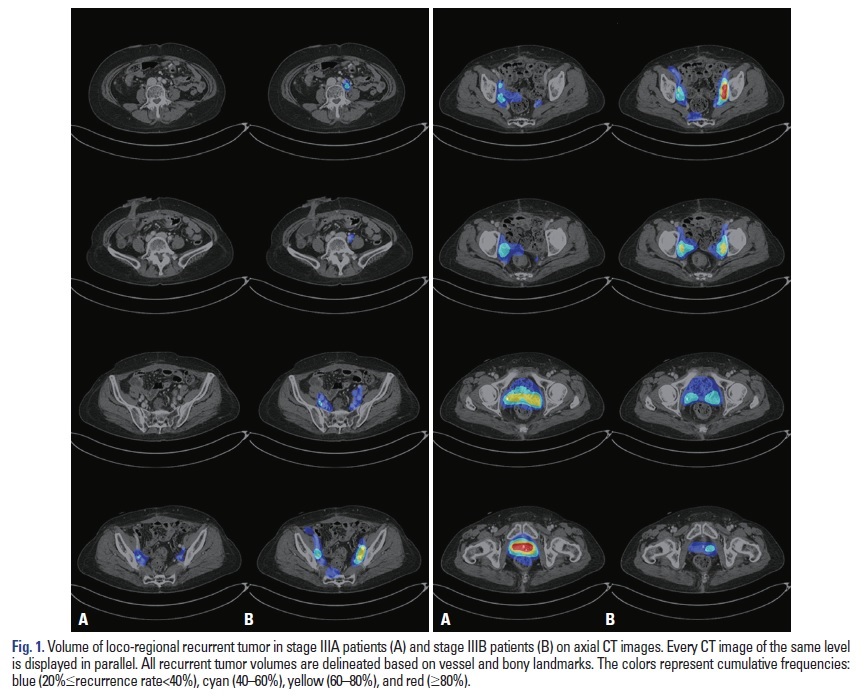글로벌 연구동향
방사선종양학
- [Yonsei Med J.] Patterns of Locoregional Recurrence after Radical Cystectomy for Stage T3-4 Bladder Cancer: A Radiation Oncologist's Point of View
연세의대 / 김현주, 금웅섭*, 함원식*
- 출처
- Yonsei Med J.
- 등재일
- 2021 Jul
- 저널이슈번호
- 62(7):569-576. doi: 10.3349/ymj.2021.62.7.569.
- 내용
Abstract
Purpose: Adjuvant radiotherapy (RT) has been performed to reduce locoregional failure (LRF) following radical cystectomy for locally advanced bladder cancer; however, its efficacy has not been well established. We analyzed the locoregional recurrence patterns of post-radical cystectomy to identify patients who could benefit from adjuvant RT and determine the optimal target volume.Materials and methods: We retrospectively reviewed 160 patients with stage ≥ pT3 bladder cancer who were treated with radical cystectomy between January 2006 and December 2015. The impact of pathologic findings, including the stage, lympho-vascular invasion, perineural invasion, margin status, nodal involvement, and the number of nodes removed on failure patterns, was assessed.
Results: Median follow-up period was 27.7 months. LRF was observed in 55 patients (34.3%), 12 of whom presented with synchronous local and regional failures as the first failure. The most common failure pattern was distant metastasis (40%). Among LRFs, the most common recurrence site was the cystectomy bed (15.6%). Patients with positive resection margins had a significantly higher recurrence rate compared to those without (28% vs. 10%, p=0.004). The pelvic nodal recurrence rate was < 5% in pN0 patients; the rate of recurrence in the external and common iliac nodes was 12.5% in pN+ patients. The rate of recurrence in the common iliac nodes was significantly higher in pN2-3 patients than in pN0-1 patients (15.2% vs. 4.4%, p=0.04).
Conclusion: Pelvic RT could be beneficial especially for those with positive resection margins or nodal involvement after radical cystectomy. Radiation fields should be optimized based on the patient-specific risk factors.

Affiliations
Hyun Ju Kim 1 , Jaehee Chun 2 , Tae Hyung Kim 3 , Gowoon Yang 2 , Sang Joon Shin 4 , Jin Sung Kim 2 , Jaemoon Yang 5 , Won Sik Ham 6 , Woong Sub Koom 7
1 Department of Radiation Oncology, Gachon University Gil Medical Center, Incheon, Korea.
2 Department of Radiation Oncology, Yonsei Cancer Center, Yonsei University College of Medicine, Seoul, Korea.
3 Department of Radiation Oncology, Nowon Eulji Medical Center, Eulji University School of Medicine, Seoul, Korea.
4 Division of Medical Oncology, Department of Internal Medicine, Yonsei Cancer Center, Yonsei University College of Medicine, Seoul, Korea.
5 Department of Radiology, Yonsei University College of Medicine, Seoul, Korea.
6 Department of Urology, Urological Science Institute, Yonsei University College of Medicine, Seoul, Korea. uroham@yuhs.ac.
7 Department of Radiation Oncology, Yonsei Cancer Center, Yonsei University College of Medicine, Seoul, Korea. mdgold@yuhs.ac.
- 키워드
- Urinary bladder neoplasms; adjuvant radiotherapy; cystectomy; recurrence.
- 연구소개
- 근침범성 T3-4 병기의 방광암에서 근치적 목적의 수술 이후 방사선치료는 국소 재발을 낮출 수 있는 장점이 있으나 골반 내 장기에 대한 부작용의 위험으로 아직 방사선치료의 역할이 명확히 정립되어있지 않습니다. 이 연구 논문은 수술 후 각 환자의 위험인자에 따른 국소 재발율 및 재발 패턴을 확인하여 방사선치료 설계에 적용할 수 있는 근거 자료로 활용하고자 진행하였습니다. 방사선종양학과 전문의에게 방광암의 근치적 수술 후 방사선치료를 결정하고 설계하는데 도움이 될 만한 연구라 생각합니다.
- 덧글달기









